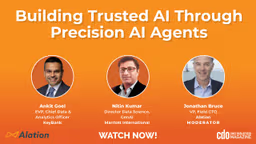Data Analytics
How Merck MSD’s Data Marketplace Enables Access, Cuts Costs, and Fuels Business Outcomes
Written by: CDO Magazine Bureau
Updated 4:14 PM UTC, Thu February 6, 2025
Following an insightful opening segment on lessons learned from implementing the internal data marketplace, Asheesh Chhabra, Associate Vice President of Data and Analytics at Merck/MSD, continues his conversation with Kevin Barboza, Partner at EY.
In this second part of the interview, Chhabra delves into how the marketplace is driving real business impact, the role of AI and modern data approaches in accelerating data access and insights, and the evolution of insight-driven applications.
Chhabra also outlines three vital takeaways for data leaders solving data, analytics, and AI challenges themselves.
Edited Excerpts:
Q
What are some key outcomes you’ve seen driven by AI or other modern approaches within the data marketplace?
A
We’re in the middle of our journey and have already achieved significant outcomes. Over the past 12 to 16 months, we’ve driven substantial impact across two key business groups—our commercial and regulatory organizations—by enabling them to share “real-world data” more effectively.
Like any other pharma company, we procure real-world data. One of our key initiatives was establishing strong procurement governance to prevent redundant data purchases — ensuring we don’t buy the same data three or four times. This has led to considerable cost savings while also allowing these two organizations to utilize the data more meaningfully, securely, and compliantly to drive better patient outcomes.
This initiative has also created a sizable business opportunity, which has been incorporated into their respective long-range operating plans.
Another critical focus has been improving speed and efficiency across the organization. We’ve built a one-stop shop where employees can easily ask, find, discover, and access the data they need. By eliminating unnecessary human middleware, we free up people to focus on complex problems rather than routine administrative tasks related to data access.
This transformation has significantly reduced cycle times—from multiple weeks to just minutes. Now, users can quickly search for the data they need, view it, and access it with a single click. They can also see the prerequisites required for usage and execute accordingly. If they have further questions, it’s immediately clear who the data steward is, making follow-ups simple and efficient.
The marketplace achieves three key objectives:
-
Enables new business use cases and outcomes that were previously unattainable
-
Enhances speed and self-service for data practitioners
-
Ensures security and compliance with a privacy-by-design approach—because just having data in the enterprise marketplace doesn’t mean everyone should have access to it.
Q
As AI initiatives scale and the relationship between AI, data, logic, and algorithms evolves, how do you see these initiatives continuing to leverage a strong foundation of well-governed data?
A
One of the areas we are actively pursuing is sharing data applications. When you access or find data, the goal is to generate insights or develop an application. There’s already a strong need to bring insight-driven applications into the marketplace, shaping how data is utilized. Traditional reports and dashboards can be considered basic insight applications, but we are now focusing on more sophisticated, well-designed data applications powered by AI and ML techniques.
We are exploring how to make these data applications more accessible—both in terms of sharing what they are and, where appropriate, sharing their code base. This prevents teams from having to build everything from scratch and instead enables them to leverage existing components as a starting point. One of our leaders refers to this as the “Lego Block” approach—building a collection of modular components that can be assembled quickly to create last-mile solutions.
As for AI enablement, it must be fueled by high-quality, highly trusted, compliant, and secure data. Without that, AI techniques won’t take you far. Instead, you’ll find yourself chasing the hallucinations of unreliable data—something we already see happening with some AI engines today.
Q
Based on your experience, what are three key takeaways you would share with data leaders who are guiding their organizations in scaling for AI?
A
-
Anchor to business problems and outcomes. What business outcome do you want to achieve with your data initiative? Having that North Star is crucial, as it ensures alignment and helps secure the right business sponsorships.
-
Secure senior leadership commitment. It’s essential to have your senior leaders fully committed to the need for data and the adoption of D&A solutions. Embedding their empathy into your vision, mission, and data strategy design will be a key factor in success.
-
Focus on architecture, technology, and skills. The technology landscape in D&A and AI is evolving rapidly with major disruptions occurring every few months. Establishing a strong reference architecture that aligns teams is critical. Equally important is upskilling your existing staff, who already have deep knowledge of your company’s data, while also complementing them with new hires who bring fresh expertise from the market.
CDO Magazine appreciates Asheesh Chhabra for sharing his insights with our global community.






